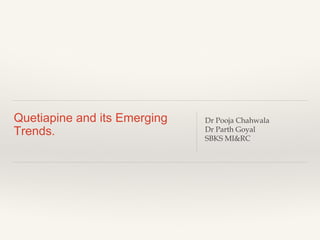
Quetiapine
- 1. Quetiapine and its Emerging Trends. Dr Pooja Chahwala Dr Parth Goyal SBKS MI&RC
- 2. History ❖ Quetiapine, trade name of Seroquel, was developed by Astra Zenca Labs, in early 1990’s. ❖ Quetiapine has a chemical structure similar to clozapine and olanzapine, thus was supposed to be a drug with similar efficacy but reduced side-effects.
- 3. FDA Approval (SZ) ❖ Quetiapine was initially marketed for the treatment of actue psychosis, seen especially in Schizophrenia. ❖ It was approved for the treatment of SZ, in 1997 after two pivotal trials, one by Small et al, and the other by Arvanitis et al. In this they used flexible and fixed doses of quetiapine and compared it with placebo and Haloperidol (12 mgs). ❖ They found quetiapine to be statistically better than placebo and equivalent to haloperidol in reducing psychotic symptoms. The dose range suggested by them was 150-750 mgs/day.
- 4. FDA Approval (Bipolar) ❖ Quetiapine was approved by FDA in January 2004 as mono therapy or adjuvant therapy with Litium or Valproate for short term treatment for acute manic episodes for acute manic disorder. ❖ It was approved as mono therapy for Bipolar Depression in October 2006. This was the result to two pivotal trials, known as BOLDER 1 & 2, followed by EMBOLDEN. ❖ These trials (RCT’s) included the use of quetiapine in doses of 300- 600 mgs, v/s placebo, for a period of 8 weeks. They concluded that patients treated to either dose were faster to respond to treatment and achieve remission than those receiving placebo.
- 5. Post Marketing Survey ❖ A post marketing survey was conducted in England on the patients receiving quetiapine. A total of 1728 patients were enrolled and they found that quetiapine was generally well tolerated without any serious side effects in clinical practice.
- 6. Drug Information ❖ Class of Drug: Second generation anti-psychotic. ❖ Uses: (Labelled Uses) ❖ Bipolar Disorder ❖ Schizophrenia ❖ MDD (adjunct to antidepressants) ❖ Uses: (Unlabelled) ❖ ICU Delirium ❖ Treatment resistant, OCD (augmentation)
- 7. Mechanism of Action ❖ Quetiapine is an atypical antipsychotic with actions mainly on D2 and 5-HT2 antagonism. ❖ Highest Affinity: H1, A1 ❖ Moderate: 5-HT2a, M1, 5-HT 7 ❖ Lowest: 5-HT2c, D2, 5-HT1a. ❖ It has a 5-HT1a partial agonistic actions, which along with it actions on 5-HT7, 5-HT2c contribute to its anti-depressant effects
- 8. MOA (Cntd) ❖ Nor-quetiapine which is the active metabolite of quetiapine, has a unique pharmacologic property. ❖ It inhibits nor-epinephrine transport. Thus contributing to the anti-depressant effects of quetiapine.
- 9. Pharmacokinetics ❖ Absorption: Rapidly absorbed orally. Should ideally be given with 300 calories for optimal effect. ❖ Vd: 6-14 L/Kg ❖ Protein Binding: 83% ❖ Metabolism: Primarily hepatic by CYP 3A4. Dosage adjustment advised when used with CYP 3A4 inhibitor or inducers. ❖ Bio-Availability: 100% ❖ Half-Life: IR: 6 Hrs, XR: 7 Hrs ❖ Time to Peak: IR: 1.5 Hrs, XR: 6 Hrs ❖ Excretion: Urine (Major), Feces (Minor), Unchanged (1%)
- 10. Dose Adjustments in Cytochrome Mutations. ❖ Concomitant use with strong CYP 3A4 inhibitor: (ketokonazole, nefazodone): Decrease quetiapine to 1/6th of the original dose when the above mentioned drugs are used. When these drugs are discontinued increase it 6 times ❖ Concomitant use with strong CYP 3A4 inducer: (phenytoin, carbamezapine): Increase quetiapine to 5 fold to original dose when combined with the above drug. When it is discontinued, decrease quetiapine to original dose within 7- 14 days.
- 11. Formulations ❖ It is usually given in extended release forms. Extended release (ER) forms are usually preferred when it is used as an anti-depressant and anti-psychotic. ❖ However when used as an hypnotic, immediate release (IR) formulations are preferred. ❖ IR is rapid onset and short duration of action.
- 13. USES and DOSES
- 15. Adverse Drug Reactions ❖ Sedation ❖ Somnolence ❖ Weight Gain and Metabolic Syndrome ❖ Hypotension ❖ Lowest incidence of EPS ❖ Decreased T4 by 20%, in a dose dependent manner (<1%)
- 17. High Risk Population ❖ Paediatric Population: Dosage adjustment is advised at an initial level while titrating the drug. ❖ Adult Population: In patients with pre-existing cardiac conditions, please monitor for QTc prolongation. Stop drug when interval > 450 ms. ❖ Accelerates the onset of cataract, theoretically. But no proof has been found in human studies. ❖ Geriatric Population: No change in dosing. Monitor for cardiac side effects. ❖ Pregnancy: Class C ❖ Lactation: Enters breast milk. Not recommended.
- 18. BLACK BOXED WARNING ❖ Increased mortality in elderly patients with dementia related psychosis. ❖ Suicidal Thoughts and behaviour: AD’s increase the risk of suicidality in young children and young adults. Quetiapine is not approved for the use in children < 10 years of age.
- 19. Emerging Trends ❖ Quetiapine has been recently used in a few conditions apart from the above mentioned use. ❖ Though these uses are unlabelled and yet unapproved by the FDA, we would still like to browse through them • ICU Delirium: Initial 50 mg/ twice daily. Max 400 mg/daily. (IR) • OCD, treatment resistant: 50 mg/once daily (1), increase to 100 mg/day (2), further increase as tolerated and required in every 2 weeks at 100 mg increments. Usual dose range 50-300 mgs daily. (IR).
- 20. WHY QUETIAPINE??? ❖ It is the only drug approved for the treatment of Bipolar Depression as mono therapy. The clinical trials mentioned above have been pivotal for FDA’s approval. ❖ It doesn't cause any Treatment Emergent Affective Switches (TEAS). ❖ Has a spectrum of actions, both on depressive and psychotic features. Thus acts like a one stop solution. ❖ It is relatively safe and does not cause any life threatening side effects. ❖ Easy dosing schedule.
